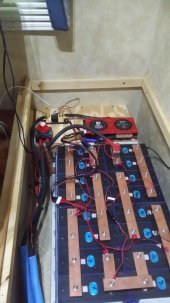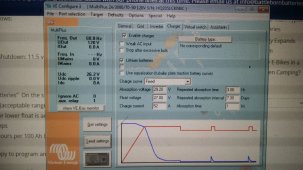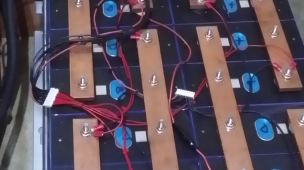interestingfellow
New Member
- Joined
- Aug 5, 2020
- Messages
- 95
Victron Multiplus 24/3000
Eve280 2p8s array
Daly 250 Smart BMS w BT
BVM712 Shunt
This is my first attempt at building an off gird power system like this. I'm about to add 2kw of solar to it, too.
I these cells were all close to each other on delivery but i did let them sit for 2 days all in parallel.
I did not top or bottom balance (I don't have a power supply and was hoping to get away with not, but now I see that maybe I should have)
I built the battery and hooked everything up.
I did set the daly to 0* low temperature cutoff, HVD of 3.65, LVD of 2.5v, and capacity to 560ah
I set the Victron to lifepo, 29.2v absorption , 27float, 52a charge limit, and 3 hour absorption time (I just saw that I set "repeated absorption time" to 3 hours by accident. I am going to go correct that right now)
I hooked everything last night and left it to charge. I woke up to the victron on float, and bvm says %100/27v, but cell #1 is at 3.5 and everything else is at 3.36v
How do I fix this? Or is the float charge driving up cell no1 while charging?
I did get all the computer and BT programs setup and working last night. When I checked today, the Daly BT was not found by SmartBMS app and I had to wake the Daly up. Does the Daly still balance when the BT goes to sleep? Isn't balancing kind of the whole point of a BMS? (/sarcasm)
I thought I had done enough reading and viewing over the last several months, but apparently there were some things I missed!
What did I do wrong to cause this? and
What do I need to do to fix this out of balance cell?
Thank you!
Eve280 2p8s array
Daly 250 Smart BMS w BT
BVM712 Shunt
This is my first attempt at building an off gird power system like this. I'm about to add 2kw of solar to it, too.
I these cells were all close to each other on delivery but i did let them sit for 2 days all in parallel.
I did not top or bottom balance (I don't have a power supply and was hoping to get away with not, but now I see that maybe I should have)
I built the battery and hooked everything up.
I did set the daly to 0* low temperature cutoff, HVD of 3.65, LVD of 2.5v, and capacity to 560ah
I set the Victron to lifepo, 29.2v absorption , 27float, 52a charge limit, and 3 hour absorption time (I just saw that I set "repeated absorption time" to 3 hours by accident. I am going to go correct that right now)
I hooked everything last night and left it to charge. I woke up to the victron on float, and bvm says %100/27v, but cell #1 is at 3.5 and everything else is at 3.36v
How do I fix this? Or is the float charge driving up cell no1 while charging?
I did get all the computer and BT programs setup and working last night. When I checked today, the Daly BT was not found by SmartBMS app and I had to wake the Daly up. Does the Daly still balance when the BT goes to sleep? Isn't balancing kind of the whole point of a BMS? (/sarcasm)
I thought I had done enough reading and viewing over the last several months, but apparently there were some things I missed!
What did I do wrong to cause this? and
What do I need to do to fix this out of balance cell?
Thank you!






